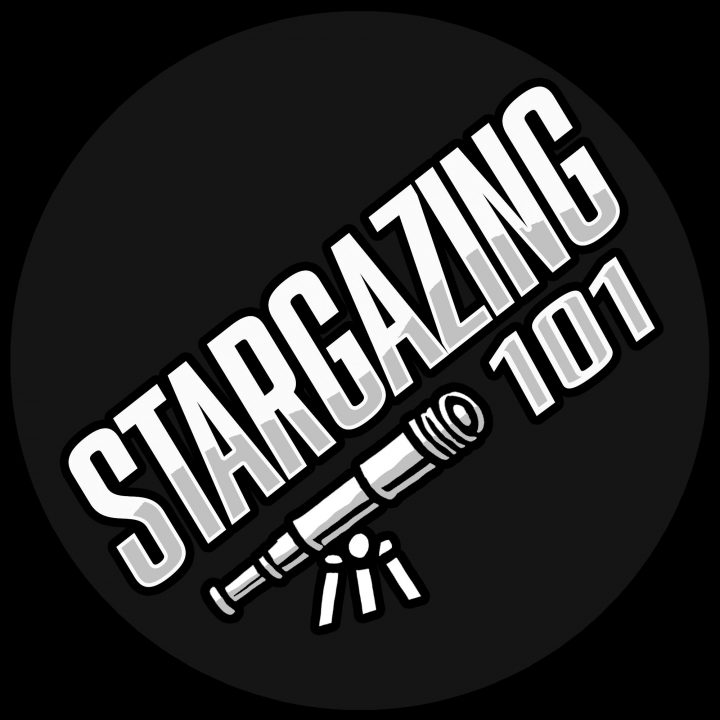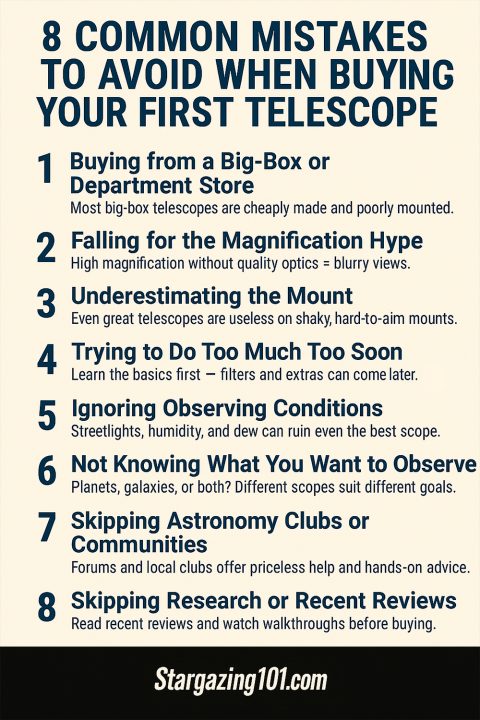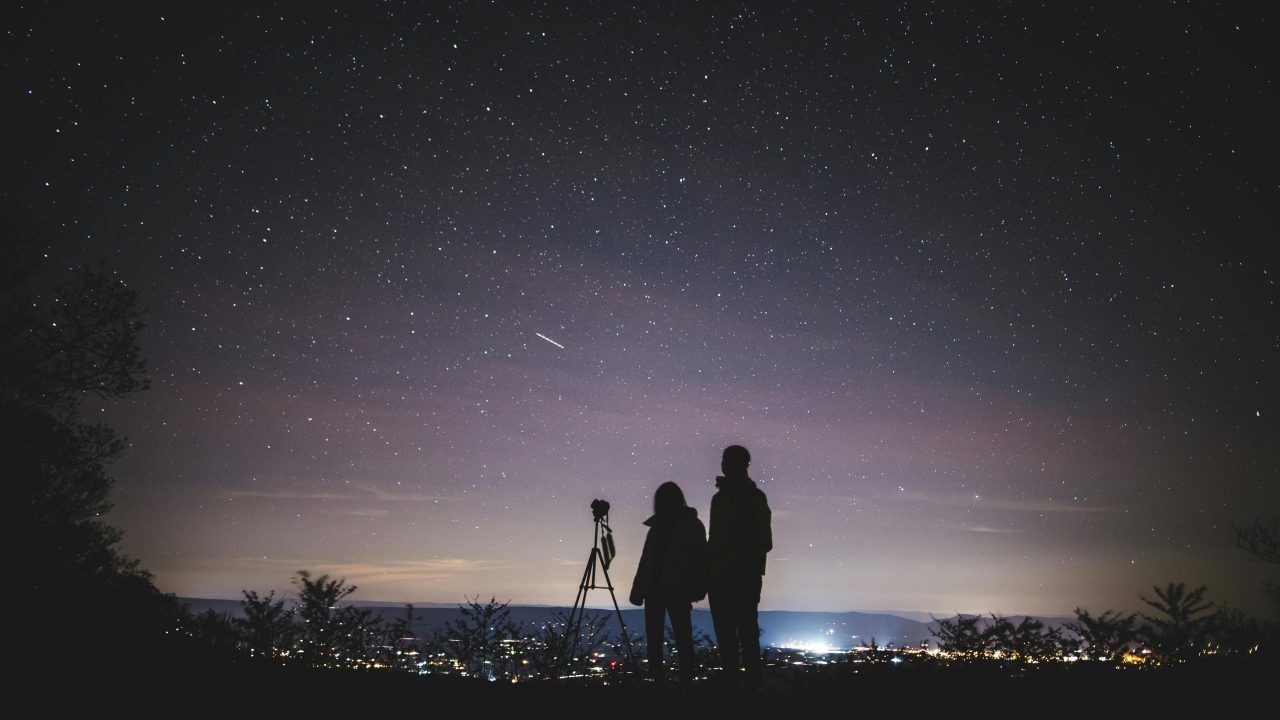
Photo by Jeswin Thomas
Starting out in astronomy is thrilling, but it’s also easy to make beginner mistakes that lead to frustration, wasted money, or giving up on the hobby entirely.
Here’s how to avoid the most common pitfalls and make sure your first telescope sets you up for success.
In a hurry? Here are the top 8 telescope-buying mistakes to avoid.
Scroll down or click the mistake for the full breakdown and smart buying tips.
1. Buying from a Big-Box or Highstreet/Department Store
Most big-box telescopes are cheaply made and poorly mounted.
2. Falling for the Magnification Hype
High magnification without quality optics = blurry views.
3. Underestimating the Mount
Even great telescopes are useless on shaky, hard-to-aim mounts.
4. Trying to Do Too Much Too Soon
Learn the basics first — filters and extras can come later.
5. Ignoring Observing Conditions
Streetlights, humidity, and dew can ruin even the best scope.
6. Not Knowing What You Want to Observe
Planets, galaxies, or both? Different scopes suit different goals.
7. Skipping Astronomy Clubs or Communities
Forums and local clubs offer priceless help and hands-on advice.
8. Skipping Research or Recent Reviews
Read recent reviews and watch walkthroughs before buying.
Bonus Cheat sheet: Pin it, Share it, or Save it.
I still remember the first time I looked through a real telescope. The rings of Saturn didn’t just impress me, they changed something. But if my first scope had been one of those shaky, overhyped toy-like models? I might’ve given up before I ever got there.
Buying the wrong telescope leads to frustration, regret, and sometimes giving up altogether. But buying the right one? That’s the start of something cosmic.
Breakdown: Each Mistake Explained
1. Buying from a Big-Box or Highstreet/Department Store
Those telescopes sold at department stores or big online retailers often look appealing, but they’re usually low-quality, poorly mounted, and frustrating to use. They’re often designed more for shelf appeal than actual performance.
What to do instead:
Shop from reputable astronomy retailers or trusted brands like Celestron, SkyWatcher, Meade, or Zhumell (there are many others out there).
2. Falling for the Magnification Hype
“600x Power!” sounds impressive, but it’s mostly marketing fluff. High magnification doesn’t guarantee better views. In fact, pushing magnification too far often leads to blurry, shaky, or dim images. And yes, I’m aware I bring this up a lot. It’s deliberate, I want to drive the point home.
What really matters:
Focus on aperture, the diameter of the main lens or mirror. A larger aperture gathers more light, giving you clearer and brighter images, especially for faint deep-sky objects.
Magnification is still important, but it shouldn’t be your main metric when shopping around. The basic rule of thumb is buy the biggest main lens or mirror you can handle and afford.
3. Underestimating the Mount
Even the best telescope won’t help if it’s sitting on a wobbly or misaligned mount. Some mounts, especially equatorial ones, require practice and proper setup. Beginners often get frustrated when the telescope won’t stay pointed or track smoothly.
Pro tip:
If you’re new, start with a simple alt-azimuth mount, which moves up/down and left/right. This is much more intuitive. If you go equatorial, be ready to learn polar alignment.
4. Trying to Do Too Much Too Soon
It’s tempting to jump into astrophotography, buy a dozen eyepieces, get a smart scope, or load up on filters right away. But that often leads to confusion and overwhelm before you even learn how your telescope works.
Start simple:
Begin with visual observing and just a few eyepieces. Once you’re comfortable finding and tracking objects, you’ll know what extras you really need and what you don’t.
5. Ignoring Observing Conditions
Your telescope doesn’t work magic on its own. If you’re set up under a bright streetlight or battling humidity and dew, your view will suffer, no matter how expensive your gear is.
Observe smart:
- Find a dark-sky location when possible.
- Let your telescope and your eyes adapt to the dark (about 20–30 minutes).
- Use red lights to preserve night vision when stargazing.
- Consider a dew shield or heater for humid nights, it’ll give you a much bigger window of viewing before your lens fogs up.
Pro tip: I usually set my telescope outside at least an hour beforehand to let it acclimate to the night air.
6. Not Knowing What You Want to Observe
Different telescopes are better for different targets. A telescope that’s great for viewing Saturn might not be ideal for faint galaxies. Beginners sometimes buy gear that doesn’t match their interests.
Ask yourself:
- Do you want to focus on planets, explore deep-sky objects, or have a versatile all-rounder?
- Are you staying in your backyard or traveling to dark-sky sites?
Knowing your goals helps you choose the right scope.
7. Skipping Astronomy Clubs or Communities
You don’t have to figure everything out alone.
Local astronomy clubs and online communities are goldmines of advice, hands-on help, and telescope tryouts.
Get connected:
Search for local clubs or join forums or Facebook groups. You can ask questions, test different gear, and learn from experienced stargazers.
8. Skipping Research or Recent Reviews
Even good brands have occasional duds. Some older telescopes have been upgraded, while others have known issues. Jumping in without doing a little research can lead to buyer’s regret.
What to do:
Read recent reviews from real users. Watch video walkthroughs on YouTube. Make sure the telescope you’re considering fits your goals, budget, and experience level.
You don’t need a perfect telescope to enjoy the night sky, you just need one that fits your needs. By avoiding these common mistakes, you’ll save money, avoid frustration, and set yourself up for a truly rewarding stargazing journey.
These eight mistakes are covered in my free beginner’s guide, How to Choose Your First (or Next) Telescope.
If you found this helpful, grab the full guide for free below:
Free PDF: Choosing Your First (or Next) Telescope
Choosing your first telescope doesn’t have to be overwhelming.
Inside this free guide, you’ll discover how to:
- Buy with confidence by understanding which telescope fits your goals
- Save time, money, and stress by avoiding beginner mistakes
- See craters, moons, and nebulae clearly with the right eyepieces
- Choose a scope that fits your life—not just your budget
- Shop smarter using a printable checklist you can take with you
Tell us where to send it, and we’ll email you the full PDF now:
Tip #11
"Jupiter’s four largest moons can be seen with binoculars and change position nightly."
-Tip #11






